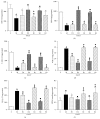Dexmedetomidine Pretreatment Attenuates Kidney Injury and Oxidative Stress during Orthotopic Autologous Liver Transplantation in Rats
- PMID: 26682005
- PMCID: PMC4670681
- DOI: 10.1155/2016/4675817
Dexmedetomidine Pretreatment Attenuates Kidney Injury and Oxidative Stress during Orthotopic Autologous Liver Transplantation in Rats
Abstract
This paper aims to explore whether pretreatment with dexmedetomidine (Dex) has antioxidative and renal protective effects during orthotopic autologous liver transplantation (OALT) and its impact on nuclear factor erythroid 2-related factor 2 (Nrf2) activation. Sprague-Dawley rats were randomized into groups that include sham-operated (group S), model (group M), low dose Dex (group D1), high dose Dex (group D2), atipamezole (a nonspecific α2 receptor blocker) + high dose Dex (group B1), ARC239 (a specific α2B/c receptor blocker) + high dose Dex (group B2), and BRL-44408 (a specific α2A receptor blocker) + high dose Dex (group B3). Then histopathologic examination of the kidneys and measurement of renal function, the renal Nrf2 protein expression, and oxidants and antioxidants were performed 8 hours after OALT. We found that pretreatment with Dex activated Nrf2 in glomerular cells and upregulated antioxidants but reduced oxidants (all P < 0.01, group D2 versus group M). Atipamezole and BRL-44408, but not ARC239, reversed these protective effects. In conclusion, pretreatment with Dex activates Nrf2 through α2A receptor, increases the antioxidant levels, and attenuates renal injury during OALT.
Figures






Similar articles
-
Dexmedetomidine Attenuates Orthotopic Liver Transplantation-Induced Acute Gut Injury via α 2-Adrenergic Receptor-Dependent Suppression of Oxidative Stress.Oxid Med Cell Longev. 2019 Nov 11;2019:9426368. doi: 10.1155/2019/9426368. eCollection 2019. Oxid Med Cell Longev. 2019. PMID: 31827710 Free PMC article.
-
Dexmedetomidine ameliorates acute lung injury following orthotopic autologous liver transplantation in rats probably by inhibiting Toll-like receptor 4-nuclear factor kappa B signaling.J Transl Med. 2015 Jun 13;13:190. doi: 10.1186/s12967-015-0554-5. J Transl Med. 2015. PMID: 26070954 Free PMC article.
-
Dexmedetomidine Protects Rat Liver against Ischemia-Reperfusion Injury Partly by the α2A-Adrenoceptor Subtype and the Mechanism Is Associated with the TLR4/NF-κB Pathway.Int J Mol Sci. 2016 Jun 23;17(7):995. doi: 10.3390/ijms17070995. Int J Mol Sci. 2016. PMID: 27347929 Free PMC article.
-
Dexmedetomidine Inhibits TLR4/NF-κB Activation and Reduces Acute Kidney Injury after Orthotopic Autologous Liver Transplantation in Rats.Sci Rep. 2015 Nov 20;5:16849. doi: 10.1038/srep16849. Sci Rep. 2015. PMID: 26585410 Free PMC article.
-
Dexmedetomidine attenuates lipopolysaccharide-induced liver oxidative stress and cell apoptosis in rats by increasing GSK-3β/MKP-1/Nrf2 pathway activity via the α2 adrenergic receptor.Toxicol Appl Pharmacol. 2019 Feb 1;364:144-152. doi: 10.1016/j.taap.2018.12.017. Epub 2018 Dec 28. Toxicol Appl Pharmacol. 2019. PMID: 30597158
Cited by
-
The Causes and Consequences of miR-503 Dysregulation and Its Impact on Cardiovascular Disease and Cancer.Front Pharmacol. 2021 Mar 8;12:629611. doi: 10.3389/fphar.2021.629611. eCollection 2021. Front Pharmacol. 2021. PMID: 33762949 Free PMC article. Review.
-
Dexmedetomidine attenuates spinal cord ischemia-reperfusion injury through both anti-inflammation and anti-apoptosis mechanisms in rabbits.J Transl Med. 2018 Jul 21;16(1):209. doi: 10.1186/s12967-018-1583-7. J Transl Med. 2018. PMID: 30031397 Free PMC article.
-
Effects of Dexmedetomidine Administered Through Different Routes on Kidney Tissue in Rats with Spinal Cord Ischaemia-Reperfusion Injury.Drug Des Devel Ther. 2022 Jul 13;16:2229-2239. doi: 10.2147/DDDT.S361618. eCollection 2022. Drug Des Devel Ther. 2022. PMID: 35860522 Free PMC article.
-
Role of Keap1-Nrf2/ARE signal transduction pathway in protection of dexmedetomidine preconditioning against myocardial ischemia/reperfusion injury.Biosci Rep. 2022 Sep 30;42(9):BSR20221306. doi: 10.1042/BSR20221306. Biosci Rep. 2022. PMID: 35959640 Free PMC article.
-
Long Noncoding RNA TCONS_00016406 Attenuates Lipopolysaccharide-Induced Acute Kidney Injury by Regulating the miR-687/PTEN Pathway.Front Physiol. 2020 Jun 18;11:622. doi: 10.3389/fphys.2020.00622. eCollection 2020. Front Physiol. 2020. PMID: 32655407 Free PMC article.
References
-
- Zhang Q., Lu M. Liver transplantation is the therapy of end stage liver diesase. Guangdong Medicine. 2005:1031–1032.
-
- Hei Z.-Q., Li X.-Y., Shen N., Pang H.-Y., Zhou S.-L., Guan J.-Q. Prognostic values of serum cystatin C and β2 microglobulin, urinary β2 microglobulin and N-acetyl-β-D-glucosaminidase in early acute renal failure after liver transplantation. Chinese Medical Journal. 2008;121(14):1251–1256. - PubMed
-
- Wei Y.-G., Li B., Yan L.-N., et al. An analysis of risk factors leading to post-liver transplantation acute renal failure. Chinese Journal of General Surgery. 2006;21(1):7–9.
Publication types
MeSH terms
Substances
LinkOut - more resources
Full Text Sources
Other Literature Sources
Medical

